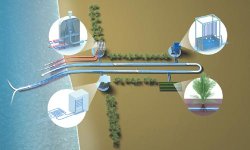The Endless Energy Well In The Deep Sea
Craven's system exploits the dramatic temperature difference between ocean water below 3,000 feet - perpetually just above freezing - and the much warmer water and air above it. That temperature gap can be harnessed to create a nearly unlimited supply of energy. Although the scientific concepts behind cold-water energy have been around for decades, Craven made them real when he founded the state-funded Natural Energy Laboratory of Hawaii in 1974 on Keahole Point, near Kona. Under Craven, the lab developed the process of using cold deep-ocean water and hot surface water to produce electricity. By the 1980s the Natural Energy Lab's demonstration plant was generating net power, the world's first through so-called ocean thermal energy conversion.The US Navy has signed a deal to put an OTEC power plant on the tiny island speck of Diego Garcia, a naval base some hundreds of miles south of India; as well, they have a project in the works to build an OTEC plant on Saipan."The potential of OTEC is great," says Joseph Huang, a senior scientist for the National Oceanic Atmospheric Administration and an expert on the process. "The oceans are the biggest solar collector on Earth, and there's enough energy in them to supply a thousand times the world's needs. If you want to depend on nature, the oceans are the only energy source big enough to tap."
Here's how Craven plans to generate power from the cold water:
Pipes draw warm water from the ocean surface and cold water from the seabed. The warm water enters a vacuum chamber and is evaporated into steam that drives an electricity-producing turbine. The cold water condenses the steam back into water for drinking and irrigation.Aside from power generation, the cold water can be used to generate freshwater (through sweating), force plants into producing more fruit than they would otherwise (he claims "he can get three crops of grapes a year and pineapples in eight months instead of the usual 18"), and provide immensely cheaper air conditioning. According to testimony (PDF) before the U.S. Commission on Ocean Policy, using deep ocean water for refrigeration reduces costs by 90%. In that same document, he presages the Engineer-Poet's call to bury nuclear power generators -- only Craven suggests they be sunk deep in the ocean. Drawing on his experience with nuclear submarine design, he writes
There is a supplementary energy resource that has already been developed and deployed for almost fifty years. It is the pressurized water nuclear reactor as employed and deployed in American military submarines. These reactors are fail safe. Unlike many land based versions of nuclear power they will not go critical if they lose their water or if they are destroyed by accident or act of terrorism. Thirteen feet of water is as effective a shield as one foot of lead. If by war or accident or terrorist sabotage they are crushed in ocean depths their tomb is shielded from the atmosphere in a way that no land based or space based reactor can match.Fascinating, mad-scientist stuff.
Update 5/27: here's a link to the Common Heritage Corporation. Further information on OTEC technology can be found at the National Renewable Energy Laboratory, which in fact no longer performs research in this area. One reason to be somewhat skeptical about the outcome of OTEC anywhere but the Hawaiian Islands is made readily apparent by this map:

The problem for most of the developed world is that it is either too shallow in the oceans near the coasts, and/or the temperature gradients are too low.



<< Home